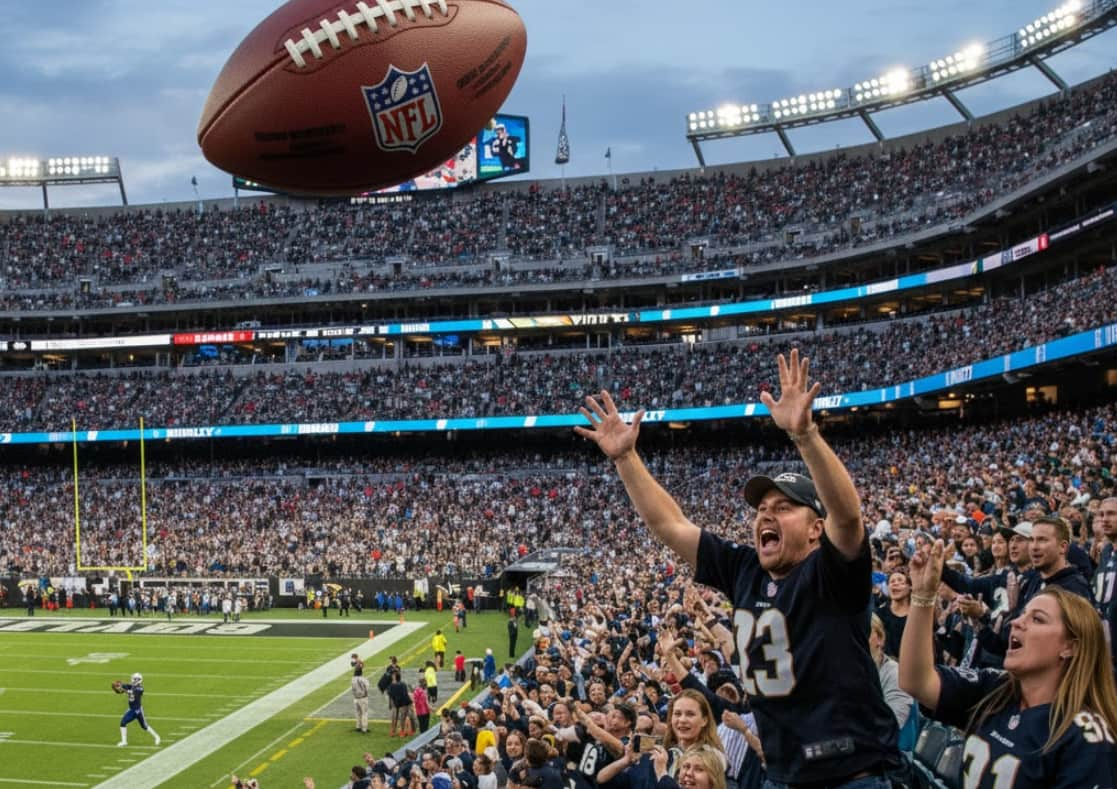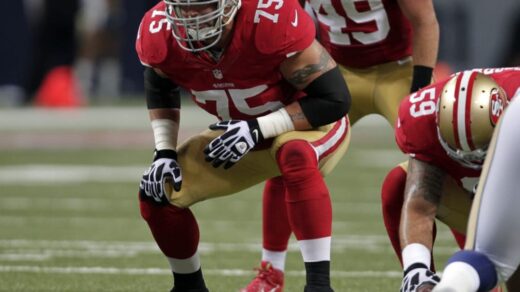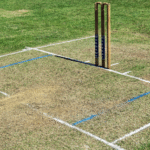Every NFL season, the same scene plays out in stadiums across America.
A rookie scores his first touchdown. Adrenaline pumping. Heart racing. Without thinking, he fires the football into the sea of celebrating fans.
The crowd goes wild. Social media explodes with videos. It’s a perfect moment captured forever.
Then Monday morning comes, and that player gets an unwelcome surprise in his inbox.
The NFL has rules about almost everything — from how you wear your socks to how you celebrate big plays. And yes, they even have rules about what you can do with the football after scoring.
Do NFL players get fined for throwing ball into stands? Thousands of fans ask this question every season, especially after watching their favorite stars interact with the crowd during emotional moments.
The truth involves safety concerns, league policies, specific dollar amounts, and a key distinction that many players wish they’d known earlier in their careers.
Some celebrations are perfectly fine. Others trigger automatic fines that get deducted straight from paychecks.
Do NFL Players Really Get Fined for Throwing the Ball Into the Stands?

The difference between the two? It’s smaller than you might think, but it matters tremendously.
Ready to find out which celebrations are safe and which ones cost thousands?
Quick Answer: Do NFL Players Get Fined for Throwing the Ball Into the Stands?
Absolutely. The NFL enforces an $8,114 fine for throwing the ball into the stands to maintain crowd safety. Players are allowed to hand a ball to a fan but not to throw it.
- Fine Purpose: Prevent crowd chaos and injuries.
- Fine Range: $8,114 for first offense, $13,911 for repeat offenders.
- Exception: Handing a ball to a fan is permitted.
- Fine Money Use: Donated to the NFL Player Care Foundation and Gene Upshaw Players Assistance Trust.
Why the Rule Exists in the First Place?
The NFL isn’t trying to be a buzzkill. There’s actually solid reasoning behind this policy, even if it frustrates fans and players alike.
When a football gets hurled into a packed stadium section, chaos can unfold in seconds.
Fans push, shove, and leap over seats trying to snag that piece of game-day memorabilia. Someone could tumble down concrete stairs.
A child could get knocked over. An unsuspecting spectator might take a football to the face.
The league classifies throwing the ball into the stands as unsportsmanlike conduct — not because it’s mean-spirited, but because it creates an unpredictable safety hazard.
NFL stadiums hold 60,000 to 80,000 people. One wild throw can spark a domino effect that stadium security can’t always control.
Beyond safety, there’s also the matter of professionalism. The NFL wants to maintain a certain image and level of order during games.
While celebrations are encouraged, they need to stay within boundaries that protect everyone involved.
So while the rule might seem strict, it’s rooted in keeping fans safe and the game environment controlled.
Breaking Down the NFL Fines List
The NFL fines list is extensive, covering everything from uniform violations to dangerous on-field conduct.
Throwing a football into the stands falls under the Sportsmanship category, alongside penalties like taunting and unsportsmanlike conduct.
Here’s how it stacks up:
| Violation | First Offense | Second Offense |
|---|---|---|
| Football Into Stands | $8,114 | $13,911 |
| Taunting | $11,593 | $17,389 |
| Unsportsmanlike Conduct | $14,491 | $20,288 |
Interestingly, throwing a ball into the stands carries a lower fine than taunting an opponent.
This suggests the NFL views it more as a safety concern than a conduct issue, whereas taunting is seen as directly disrespectful and harmful to the game’s integrity.
Still, compared to uniform violations — which can be as low as $5,797 for wearing the wrong socks — the football fine is substantial. The message is clear: celebrate, but do it responsibly.
How Much Does an NFL Player Get Fined for Throwing a Ball Into the Stands?
Let’s break down the numbers clearly.
- First Offense: $8,114
- Second Offense: $13,911
These fines are part of the league’s standard penalty structure, which gets updated periodically based on the collective bargaining agreement between the NFL and the Players Association.
The amounts increase with repeat violations to discourage players from making it a habit.
What happens if a player throws a ball into the stands multiple times?
The fine escalates, and the player might face additional scrutiny from league officials.
While it’s unlikely someone would get suspended for this alone, repeated violations could contribute to a pattern of conduct issues that bring harsher consequences down the line.
For context, the average NFL salary is around $2.8 million per year, though practice squad players and rookies earn far less.
For a star quarterback, $8,114 is pocket change. For a rookie on the minimum salary, it’s a noticeable hit.
Fan Reaction: Is It Really Fair?
This is where things get interesting. Ask any group of NFL fans about this rule, and you’ll get passionate opinions on both sides.
- Team “Let Them Celebrate”:
Many fans argue that tossing the ball into the stands is one of football’s most authentic, joyful moments. It connects players with supporters, creates unforgettable memories, and embodies the spontaneous excitement that makes sports special. Why punish players for sharing their success with the people who paid to watch?
- Team “Safety First”:
Others understand the NFL’s position. They’ve seen the videos of fans trampling each other for foul balls at baseball games or getting injured in stadium scuffles. If someone gets hurt because a player threw a football, the lawsuits and backlash would be massive. Better to prevent the problem entirely.
- The Middle Ground:
Most fans fall somewhere in between. They appreciate the safety reasoning but wish the NFL would allow controlled celebrations — maybe only in certain designated sections, or with softer, underinflated balls specifically for fan giveaways.
Social media lights up every time this happens. Fans tweet photos of the lucky recipient holding the ball, while others joke about the player’s impending fine. It’s become part of NFL culture, a quirky rule that everyone knows but few truly love.
Do You Get Fined for Throwing a Ball Into Stands If It’s to a Kid?
This brings us to one of the most frequently asked questions: Did Texans Collins get fined for throwing a TD ball to kid in stands?
The answer depends entirely on how it happened.
- If Nico Collins (or any player) threw the ball — even if aiming directly at a young fan — the fine applies. The NFL’s policy doesn’t distinguish between throwing to a specific person versus launching it randomly. A throw is a throw.
- If he handed the ball directly to the child — walking over to the stands and placing it in their hands — no fine. In fact, these moments often go viral and earn praise from the league and media alike.
This distinction might seem minor, but it makes all the difference. Players have learned this lesson over the years. Now, most savvy veterans make sure to approach the stands and hand the ball over personally, creating an even more memorable interaction without the penalty.
The confusion arises because, from a fan’s perspective in the upper deck watching on the big screen, the difference between a controlled toss and a gentle handoff isn’t always obvious. But the NFL reviews game footage closely, and the rule is enforced consistently.
Largest NFL Fine for a Player — Putting It in Perspective
While $8,114 might sound like a lot for tossing a football, it’s actually one of the smaller fines in the NFL ecosystem.
Here are some significantly larger penalties:
- Fighting: $40,686 (first offense), $81,374 (second offense)
- Physical contact with a game official: $40,686
- Impermissible use of the helmet (launching): $23,186
- Roughing the passer: $17,389
- Horse collar tackle: $17,389
The largest NFL fine for a player can reach well into six figures for egregious conduct violations, repeat dangerous play, or off-field issues that harm the league’s reputation.
In comparison, the football into stands fine is modest. It’s designed to correct behavior, not devastate a player’s bank account.
The NFL wants to discourage the action without being overly punitive, recognizing that the intent is usually celebratory rather than malicious.
What Happens If a Player Throws a Ball Into the Stands by Accident?
Great question. What if a player fumbles near the sideline and the ball bounces into the crowd?
Or what if they spike it in celebration and it ricochets off the turf into the stands?
Generally, intent matters. The NFL reviews each incident individually.
If it’s clearly accidental — like a fumble recovery celebration gone wrong — officials may use discretion.
However, the policy is written broadly enough that even accidental violations could technically be penalized.
Most of the time, though, fines are reserved for obvious, deliberate throws.
The league doesn’t want to punish players for freak occurrences, only for intentional actions that create risk.
Players also get official notification before fines are deducted from their paychecks, giving them a chance to appeal if they believe the penalty was unwarranted.
While appeals rarely overturn sportsmanship fines, the system does allow for context and review.
Where Does the Fine Money Go?
Here’s the silver lining: every dollar collected from NFL fines goes to charity.
The Players Association and the league jointly donate all fine money through the NFL Foundation to two key programs:
- NFL Player Care Foundation: Provides medical, emotional, and financial support to former players and their families
- Gene Upshaw Players Assistance Trust: Offers emergency financial help to retired players facing hardship
These programs fund:
- Mental health services
- Medical treatments and screenings
- Disaster relief
- Educational resources
- Financial counseling
So while getting fined stings for the player, at least the money supports the football community.
Former players who built the league’s legacy benefit directly from these penalties, receiving care and assistance they might not otherwise afford.
It’s one of the better aspects of the NFL’s discipline system — turning penalties into positive impact for those who need it most.
Final Word: A Costly Celebration
Yes, NFL players get fined for throwing the ball into the stands, and the debate over whether that’s fair probably isn’t going away anytime soon.
From the league’s perspective, the $8,114 fine represents a commitment to fan safety and professional standards.
From the players’ viewpoint, it’s a frustrating restriction on spontaneous celebration.
And from the fans’ perspective, it’s a mixed bag — some understand the reasoning, while others just want to catch a game ball.
The good news? Players can still create magical moments by handing balls directly to fans, especially kids.
These personal interactions often mean more than a random throw anyway, creating memories that last a lifetime.
And if a player does decide to launch that football into the stands in the heat of celebration?
Well, at least they know the money goes toward helping their fellow players. It’s a costly celebration, but one with a purpose beyond the penalty.
So next time you see a player score and carefully hand the ball to a young fan in the front row, you’ll know exactly why — and appreciate the moment even more.







